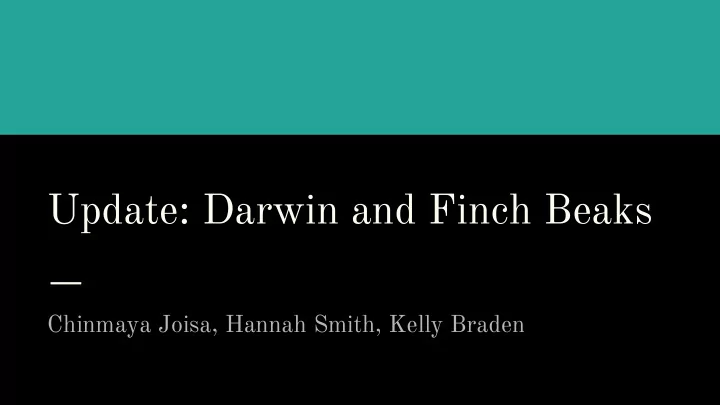

Update: Darwin and Finch Beaks Chinmaya Joisa, Hannah Smith, Kelly Braden
Recall classic adaptive radiation
What is the genetic/molecular basis of the finch adaptive radiation?
A beak size locus in Darwin’s finches facilitated character displacement during a drought (Lamichhaney et al. 2016)
Introduction
Foundation of the Experiment ● Whole-genome sequencing of 60 Darwin finches (6 species) were used ● These included small, medium, and large ground and tree finches ● They were studied on the Daphne Major in the Galápagos Islands during a severe drought
Resource Competition • Species may diverge in traits • Beak sizes started to diverge during the drought • The medium ground finch with the large beak had a disadvantage competing for food against the large ground finch
Beak Information ● Beak size and body size are strongly correlated (r=.7 to .8) ● Stronger association between survival and beak size (S= -1.02, P< .0001) than between survival and body size (S= -.67, P< .05) ● Beak dimensions and overall body size are highly heritable ● Regulatory gene, ALX1, was identified in regulating variation of beak shape
● Genome-wide screen for loci affecting beak size and body weight Summary of ● Phylogenetic tree generation analyses ● Genome-wide differentiation and selection of candidate genes ● Haplotype and fitness analysis of candidate HMGA2 gene in the population
Experiments & Results
Correlation of Morphological Differences Fig. 1 A & B: Diversity in Population Means For Beak Size and Body Weight
Maximum Likelihood Phylogenetic Tree from sequence data Fig 1 C&D: Computationally generated phylogenetic trees using all polymorphic autosomal loci (C) and 525-kb region around HGMA2 (D) * indicates nodes in the phylogenetic tree confirmed by the Shimodaira-Hasegawa test for likelihood of statistically significant sequence alignment
Genome-wide Fixation Index (F-st) Test for Genetic Differences between Size Groups
Selection of significant SNPs and PhastCon analysis
Selection of significant SNPs and PhastCon analysis Fig 2C: Results of PhastCon analysis between finches and mammals
Genotypic analysis at selected SNPs in sampled groups Fig 2D: Comparison of Homozygous Large (LL), Heterzygous Large/Small (LS) and Homozygous Small (SS) alleles in the 17 SNPs selected from F-st and PhastCon analysis
Regression Analysis of Genotypes vs size/shape characteristics
Survival Percentage According to HMGA2 Genotype of Medium Ground Finches
Conclusion ● HMGA2- Gene controlling beak size also in chickens and zebra finch ○ Additive effect of gene ○ ALX1- Beak shape ○ Also relevant in human heights and sizes of mice ● Single locus caused rapid diversification due to very high .59 土 0.14 selection coefficient ● A single locus can have a very large effect in a population over a short amount of time
Possible Future Research ● Sequence Darwin’s finches to confirm location of HMGA2 gene ● Look at HMGA2 in chickens and analyze how it affects the size of the beak ○ Search for mechanism affecting beak shape and growth ● Observe how the fitness and phenotypic frequencies change if the environment changes again
Recommend
More recommend